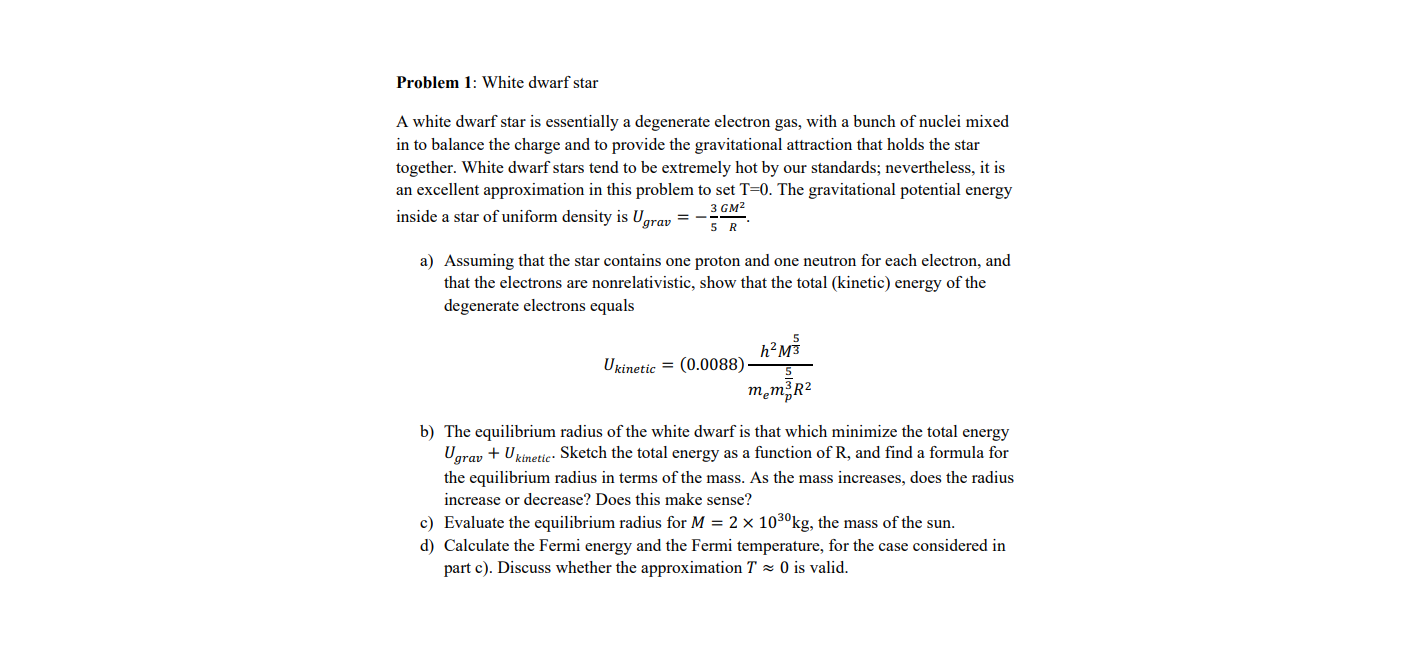Problem 1: White dwarf star A white dwarf star is essentially a degenerate electron gas, with a bunch of nuclei mixed in to balance the charge and to provide the gravitational attraction that holds the star together. White dwarf stars tend to be extremely hot by our standards; nevertheless, it is an excellent approximation in this problem to set T=0. The gravitational potential energy inside a star of uniform density is Ugrav = 3 см2 a) Assuming that the star contains one proton and one neutron for each electron, and that the electrons are nonrelativistic, show that the total (kinetic) energy of the degenerate electrons equals h²M³ Ukinetic = (0.0088)- męm R? b) The equilibrium radius of the white dwarf is that which minimize the total energy Ugrav + Ukinetie: Sketch the total energy as a function of R, and find a formula for the equilibrium radius in terms of the mass. As the mass increases, does the radius increase or decrease? Does this make sense? c) Evaluate the equilibrium radius for M = 2 × 103°kg, the mass of the sun. d) Calculate the Fermi energy and the Fermi temperature, for the case considered in part c). Discuss whether the approximation T 0 is valid.
Problem 1: White dwarf star A white dwarf star is essentially a degenerate electron gas, with a bunch of nuclei mixed in to balance the charge and to provide the gravitational attraction that holds the star together. White dwarf stars tend to be extremely hot by our standards; nevertheless, it is an excellent approximation in this problem to set T=0. The gravitational potential energy inside a star of uniform density is Ugrav = 3 см2 a) Assuming that the star contains one proton and one neutron for each electron, and that the electrons are nonrelativistic, show that the total (kinetic) energy of the degenerate electrons equals h²M³ Ukinetic = (0.0088)- męm R? b) The equilibrium radius of the white dwarf is that which minimize the total energy Ugrav + Ukinetie: Sketch the total energy as a function of R, and find a formula for the equilibrium radius in terms of the mass. As the mass increases, does the radius increase or decrease? Does this make sense? c) Evaluate the equilibrium radius for M = 2 × 103°kg, the mass of the sun. d) Calculate the Fermi energy and the Fermi temperature, for the case considered in part c). Discuss whether the approximation T 0 is valid.
Related questions
Question

Transcribed Image Text:Problem 1: White dwarf star
A white dwarf star is essentially a degenerate electron gas, with a bunch of nuclei mixed
in to balance the charge and to provide the gravitational attraction that holds the star
together. White dwarf stars tend to be extremely hot by our standards; nevertheless, it is
an excellent approximation in this problem to set T=0. The gravitational potential energy
inside a star of uniform density is Ugrav =
3 см2
a) Assuming that the star contains one proton and one neutron for each electron, and
that the electrons are nonrelativistic, show that the total (kinetic) energy of the
degenerate electrons equals
h²M³
Ukinetic = (0.0088)-
męm R?
b) The equilibrium radius of the white dwarf is that which minimize the total energy
Ugrav + Ukinetie: Sketch the total energy as a function of R, and find a formula for
the equilibrium radius in terms of the mass. As the mass increases, does the radius
increase or decrease? Does this make sense?
c) Evaluate the equilibrium radius for M = 2 × 103°kg, the mass of the sun.
d) Calculate the Fermi energy and the Fermi temperature, for the case considered in
part c). Discuss whether the approximation T 0 is valid.
Expert Solution
This question has been solved!
Explore an expertly crafted, step-by-step solution for a thorough understanding of key concepts.
This is a popular solution!
Trending now
This is a popular solution!
Step by step
Solved in 7 steps with 8 images
